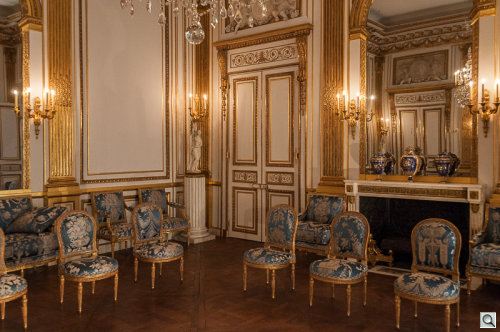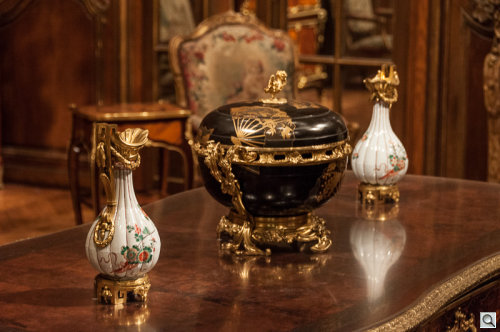Photo Corners headlinesarchivemikepasini.com
![]()
A S C R A P B O O K O F S O L U T I O N S F O R T H E P H O T O G R A P H E R
![]()
Enhancing the enjoyment of taking pictures with news that matters, features that entertain and images that delight. Published frequently.
Friday Slide Show: Two French Period Rooms




15 August 2014
Photographing in museums is constrained by the need to conserve the artwork. The policy at the Legion of Honor in San Francisco, permits you to photograph in the permanent galleries "without flash, artificial light and hand-held only." No tripod, no flash.
THE PROBLEM
That can be a difficult challenge because light levels are kept low. And bumping up ISO or using a fast prime lens introduce their own problems.
High ISO brings noise and loses detail while fast primes are very difficult to focus because the microlenses of your camera's focusing screen show more depth of field at wide apertures than what the lens actually captures.
We proved that to ourselves last month when we shot with a 50mm f1.4 Nikkor in two French period rooms at the Legion. To get a hand-held sharp image, we had to shoot at about 1/30 second and that meant an aperture of f4 at ISO 800. In the brightest room. We didn't fare as well in the two period rooms, which are darker.
The more famous of the two rooms, the Salon Doré has just been restored. Its wedding cake walls would seem to be bright but the level of illumination mimicks a candlelit evening.
The other room is paneled in unpainted wood and even darker. But we love the rich tones that set off the decorative pieces and the furniture in the room. In contrast the Salon Doré seems unfurnished.
With the 50mm lens, we had to open up to f2 and because we were focusing through the viewfinder (having neglected to bring our eyeglasses). And we were off a bit. Something was in focus but not the plane we had hoped, despite our bouncing back and forth to find the sweet spot.
We didn't suffer camera shake and ISO 800 was certainly usable. But we didn't get the depth of field, the precise focus plane or even the composition we wanted.
On our next visit we solved those problems.
TWO SOLUTIONS
We comfortably shot the 50mm lens at f2 for 1/60 second, using Live View (and our glasses) to focus. We used 1/60 second to avoid any camera shake from Live View itself.
We looked like a photographer with a smartphone or digicam, holding the camera in front of us to take the shot. But as we have explained elsewhere, Live View has four advantages:
The first is that it shows you precisely what the sensor sees. It isn't an approximation like your optical viewfinder. There's no back or front focusing with a manual focus lens, no mechanical compromise, no slight disagreement between the optical path to the viewfinder and the path to the sensor. It's exactly what you're going to get when you snap the shutter.
The second is that it lets you magnify the image. This is what makes it so useful in macro photography. But it also helps in those situations where you just can't quite see what's in focus. It lets you peer in a little more closely to see what's going on.
The third is that the auto gain of the LCD when stopping down the lens brightens the image so you can more easily see the effect of a smaller aperture. Depth of field preview becomes easier to appreciate in Live View than the darkened port of the optical viewfinder.
And a fourth reason is you can superimpose a grid on the LCD so you can make sure you're shooting level.
The only issue it didn't address, in fact, was the composition. You can't wander around in the period rooms. You are restricted to a narrow pathway leading from one door to the other along one wall. That's it.
So we went through the rooms a second time with an autofocusing 18-200mm Nikkor zoom that let us get closer to things and also had the advantage of optical stabilization.
We kept ISO at 800 but with this lens our aperture fluctuated from f4 to f5.6, depending on the focal length. The more we zoomed in (to get some vase on the far wall, for example), the smaller our widest aperture became. Our shutter speed had to compensate and fell to 1/15 second. We wouldn't have been able to hand hold that without optical stabilization. Our shots were sharp.
In the two slide shows, most of the images were taken with the zoom. Three in each room were taken by the prime. In the Salon Doré, the first, third and tenth were taken with the prime. In the wood paneled room, the second, sixth and ninth were taken with the prime.
EDITING
Playback on the LCD didn't really tell us much on site. It wasn't until we imported the images into Lightroom that we could tell how well we did.
We had shot Raw only, so we had to establish a white balance for the images.
For some other images of Rodin marbles, we relied on a Whibal for a reference shot, setting the white balance from the card using Lightroom's eye dropper.
Alternately when on site, you could shoot a JPEG (with a custom white balance for the unknown lighting setup), checking to make sure it captures the color accurately. You can subsequently apply the temperature and tint values of the JPEG to your Raw captures.
For the rooms, we relied on our previous shots, which we'd already color balanced. We simply noted the Color Temperature and Tint and applied them to the relevant images. And they sprang to life.
For our longest focal length images, we had to increase exposure a bit. We also found we had to darken our highlights and open up our shadows. And we sprinkled everything with a little Clarity, too.
We didn't worry about noise because we were reducing the images to 800 pixels on the long side for this presentation and the noise would disappear as the pixels were binned together.
We did do a little perspective correction, too. There were so many verticals in the images, we couldn't avoid it.
It would be misleading to suggest these renderings are accurate, though. The Salon, in particular, is so poorly lit it seems dingy (which is probably historically correct). And the paneled room is much warmer in these shots than in reality. Both enjoy a boost in illumination, as well. So, in short, we've improved the view.
The first time we shot these rooms at the Legion, we could barely find an image we wanted to publish. But this time, we really had a hard time limiting it to two slide shows.
Next time? Well, maybe we'll tag along with Cultural Heritage Imaging, which did some unusual work at the Legion themselves a little while ago.

